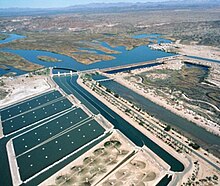Tee building

A tee structure (engl. "Diversion dam") is a dam which forms part of or the entire effluent of a flow is derived from its natural course. Tees do not generally hold back water in a reservoir or reservoir. Instead, the runoff is channeled into an artificial watercourse or canal to enable irrigation or to return it to the original river after electricity has been generated with the help of generators ; in addition, the water can be diverted into another river or only serve to damming a reservoir.
The Sadd el-Kafara in Wadi Al-Garawi in Ancient Egypt , which was located about 25 km south of Cairo , is an early breakout structure . For flood protection around 2,600 BC Built in BC, it was 102 m long and 87 m wide at the base. It was destroyed by a flood during the construction phase.
classification
According to the classification of Goings, there are two other types of dams in addition to tipping structures: storage dams and flood protection dams. Storage structures are built to store water for a longer period of time. The stored water can be used for irrigation , for drinking cattle , for local water supply, recreation and electrical energy generation. Flood protection dams are built to intercept surface runoff and prevent flooding; They can also serve as sediment traps by regulating the flow rate into watercourses below. Tee structures are used to raise the water level and thus direct the water to its destination. The diverted water can be used for irrigation or storage; Electric power generation and municipal water supply are also possible purposes.
Construction work
The design of a building structure can be divided into four basic types: embankment style, buttress style, arches and gravity style dams ").
Debris Dam
Debris dams are built to provide enough weight to counteract the energy of the water acting on the dam. Debris dams are usually constructed from materials available in the area. This generally includes: sand, gravel and rocks. The connection of these building materials with clay or an impermeable membrane gives the dam its stability. In the end, the combination of simple construction and materials available on site mean that the costs are lower than for other dam types.
Buttress dam
Abutment structures built from support pillars are designed so that angular structures support the downstream side of the dam. The supporting pillars are attached to the dam wall to counteract the energy of the water. Dams with buttresses are built across wide valleys that have no rock-solid bottom. The rock floor consists of standing rock that extends to the surface. This bedrock can consist of sedimentary, volcanic or metapmorphic rock. Buttress dams require excessive use of steel and manpower; they are therefore expensive and are rarely built these days.
Arch dams
Arch dams are constructed using a curved surface, with the arch of the arch facing upstream. The arch creates additional strength to counteract the energy of the water. Arch dams are generally built in narrow ravines; they are usually made of concrete. In order to provide stability to the dam, solid contact between the surrounding rock and the concrete base of the dam is required. The dome shape is a possible implementation of an arch dam; it is arched in both the vertical and horizontal directions, while a normal arch dam is arched only in the horizontal direction.
Gravity dam
Gravity dams are built to withstand the water not through stability, but through their own weight; they are usually constructed from masonry or cement. The foundation of the gravity dams generally takes place on a rock foundation. However, they can be built anywhere as long as it is ensured that no water flows under the dam. A flow of water under the dam could cause it to break.
See also
- Flood relief
- Flood protection
- Flood gate
- Reservoir
- flow
- Brook
- Dike
- Contactor
- channel
- Storm surge
- River bifurcation
Individual evidence
- ↑ Günther Garbrecht: Water reservoirs (dams) in antike , Antike Welt , 2nd edition: Antiker Wasserbau (1986), pp. 51–64 (52f.)
- ↑ Mohamed Bazza: Overview of the History of Water Resources and Irrigation Management in the Near East Region (PDF) In: Food and Agriculture Organization of the United Nations . October 28–30, 2006. Archived from the original on August 8, 2007. Retrieved August 1, 2007.
- ↑ a b c d e f g David B. Goings: K. Lee Lerner and Brenda Wilmoth Lerner (Eds.): The Gale Encyclopedia of Science (Web), Gale, Detroit 2004, pp. 1149-1152 (accessed 23. February 2013).
- ↑ K. Lee Lerner and Brenda Wilmoth Lerner (Eds.): The Gale Encyclopedia of Science (Web), 3rd. Edition, Gale, Detroit 2004, pp. 468-469 (accessed February 22, 2013).
